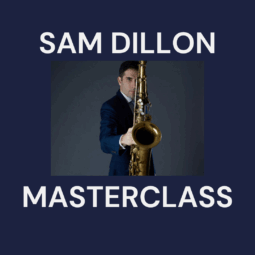
Last activity on November 3, 2025
Joining us from the vibrant New York jazz scene, saxophonist Sam Dillon delivers a profound and inspiring masterclass that transcends mere technique, guiding musicians toward true freedom in their musical expression. Through his in-depth exploration of the diminished scale, triads, and their application over chord progressions—particularly the II-V-I sequence—Sam reveals how mastering specific musical language elements can unlock unlimited creativity and emotional depth in your playing.
This course is designed not just to teach you new scales or patterns but to evolve your entire approach to improvisation, making you a better, more confident, and expressive musician. Whether you’re a saxophonist, pianist, guitarist, or any improviser, the insights Sam shares will enrich your vocabulary and empower you to tell compelling musical stories.
Sam passionately emphasizes that the journey to freedom in music is paradoxically rooted in deep specificity and focused practice. Unlike the common myth that jazz improvisers are just “free playing”, true freedom arises from mastering vocabulary and internalizing patterns so profoundly that they emerge naturally and effortlessly in performance.
Master Specific Ideas to Gain Freedom: Sam teaches that by focusing on one phrase or concept—like a specific diminished scale pattern—and drilling it thoroughly in all keys, you build a vocabulary that becomes second nature. This vocabulary acts like words in a language, allowing you to “speak” fluently and expressively without hesitation.
Internalize, Then Express: Learning is a process of repetition and internalization. You repeat and drill specific material until you no longer think about it consciously but can use it creatively in any musical context. This balance between deliberate practice and spontaneous use leads to musical freedom.
Apply Theory to Real Playing: This is not abstract theory. Sam insists you must apply what you practice, whether on a simple blues or a complex tune, so the new vocabulary becomes part of your musical identity, not just something you can do in isolation.
Stay Active Musically: Playing regularly—even humble $20 gigs—keeps your musical dialogue alive. Like speaking daily with loved ones, consistent gigging maintains your musical fluency and creativity.
By following this approach, you will hear yourself evolving not just technically but as a storyteller, conveying ideas that move and connect with your listeners.
Sam anchors his lesson on the jazz fundamental—the II V I progression—as a framework to explore the diminished scale and triads. Understanding this common harmonic movement gives you a structured yet flexible playground for improvisation.
The diminished scale is a symmetrical eight-note scale with alternating whole and half steps (depending on the type). Sam reveals why it’s so powerful:
One of the most transformative parts of the masterclass is the exploration of triads extracted from the diminished scale:
Sam introduces advanced “four-note” voicings formed by combining diminished chords, including the diminished major 7 chord—a sound common in modern jazz harmony and favored by luminaries like Herbie Hancock.
Sam stresses the importance of:
By mastering the diminished scale methodically through this course, you will:
Sam’s personal journey—from meticulously copying masters to developing his own voice—serves as inspiration. He shows that great technique and freedom come from patient work, smart practice, and passion.
This course is more than just about diminished scales and triads; it’s a transformational toolkit for any improviser aiming to break free from repetitive patterns and find genuine, personal freedom in jazz. With Sam Dillon as your guide, you not only learn sophisticated jazz vocabulary but also how to harness it expressively, making yourself a more compelling musician and a more authentic storyteller.
By investing in this masterclass, you invest in yourself—your musical growth, your confidence, and your ability to move others through your art. Embrace the process of focused practice, stay patient, engage deeply with the language of jazz, and discover your unique voice that resonates with both tradition and innovation.
Join Sam Dillon on this exciting journey. Elevate your playing, enrich your musical life, and ultimately, feel better about yourself knowing you are progressing toward true mastery and freedom in jazz.
Enroll now and start creating music that speaks directly from your heart with brilliance, clarity, and individuality. Your next great solo awaits!
Terms of Service | Privacy Policy